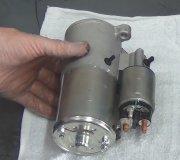Many people will tell you that two-year-old gas is stale and is the cause of the no-start, but I have a fuel injected car and a carbureted car both with more than five-year-old gas, and they both run just fine. Also, stale gas will flood the engine and foul the spark plugs so the engine would not run on starting fluid. Given that it was running six months ago, I'm inclined to believe the fuel pump has quit. Referring to Chrysler products again, their pumps almost always fail by failing to start up, unlike GM pumps that almost always start up, then quit while they're running letting you sitting on the side of the highway. Chrysler pumps rarely quit while they're running.
Look for a fuel pressure test port on top of the engine. If there is one it will look similar to a tire valve on a metal pipe. Remove the cap and press the valve stem. Fuel should shoot up a couple of feet. If there's no pressure, bang on the bottom of the gas tank while a helper cranks the engine. The engine has to be rotating, (cranking or running), for the pump to be turned on. If it's dead due to worn brushes, there's about a 75 percent chance banging on the tank will get it going. At that point it is likely to stay running as long as the engine is running, and it will typically work okay for weeks or months after that.
When looking for that test port, follow the pipe to see that it attaches to a small rubber hose on the body that goes back to the gas tank. I hope I'm not telling you obvious stuff you already know. There will be two similar-looking ports on the two metal lines attached to the air conditioning compressor. They won't have the same kind of stem in the center. Don't mess with those because escaping refrigerant can cause frostbite and blindness.
If there is no fuel test port, listen next to the fuel tank. You should hear the hum of the fuel pump for one second when a helper turns on the ignition switch. If you don't hear that, the pump isn't running.
Saturday, April 20th, 2013 AT 11:15 PM



